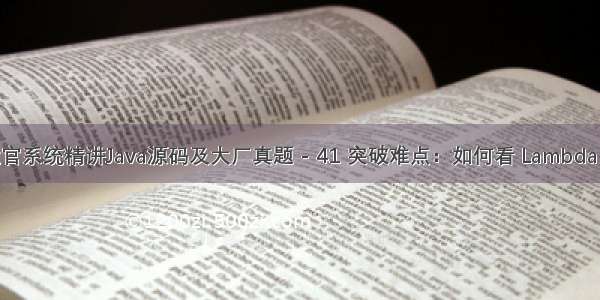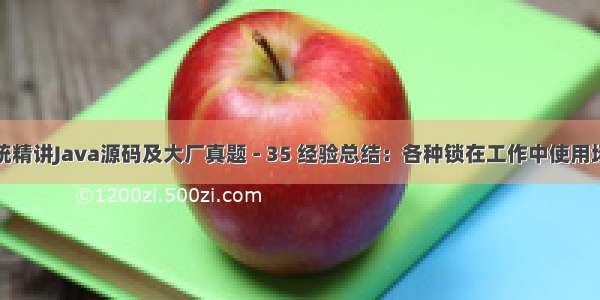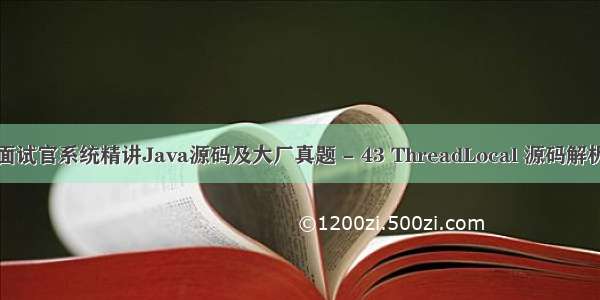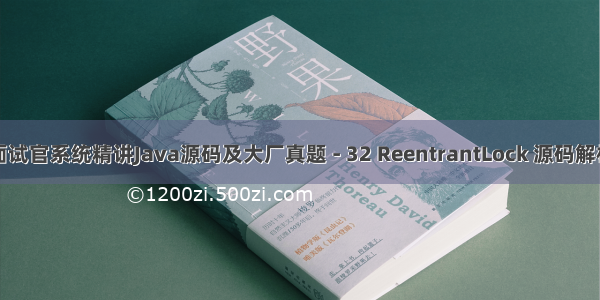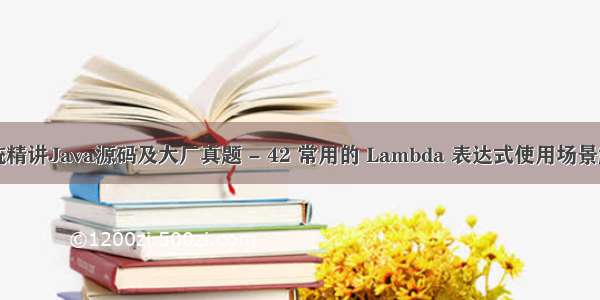
42 常用的 Lambda 表达式使用场景解析和应用
引导语
我们日常工作中,Lambda 使用比较多的场景,就是 List 或 Map 下的 Lambda 流操作,往往几行代码可以帮助我们实现多层 for 循环嵌套的复杂代码,接下来我们把 Lambda 流的常用方法用案列讲解一下。
1 数据准备
本文演示的所有代码都在 demo.eight.LambdaExpressionDemo 中,首先我们需要准备一些测试的数据,如下:
@Data// 学生数据结构class StudentDTO implements Serializable {private static final long serialVersionUID = -7716352032236707189L;public StudentDTO() {}public StudentDTO(Long id, String code, String name, String sex, Double scope,List<Course> learningCources) {this.id = id;this.code = code;this.name = name;this.sex = sex;this.scope = scope;this.learningCources = learningCources;}/*** id*/private Long id;/*** 学号 唯一标识*/private String code;/*** 学生名字*/private String name;/*** 性别*/private String sex;/*** 分数*/private Double scope;/*** 要学习的课程*/private List<Course> learningCources;}@Data// 课程数据结构class Course implements Serializable {private static final long serialVersionUID = 289630223729591L;/*** 课程 ID*/private Long id;/*** 课程 name*/private String name;public Course(Long id, String name) {this.id = id;this.name = name;}}// 初始化数据private final List<StudentDTO> students = new ArrayList<StudentDTO>(){{// 添加学生数据add(new StudentDTO(1L,"W199","小美","WM",100D,new ArrayList<Course>(){{// 添加学生学习的课程add(new Course(300L,"语文"));add(new Course(301L,"数学"));add(new Course(302L,"英语"));}}));add(new StudentDTO(2L,"W25","小美","WM",100D,Lists.newArrayList()));add(new StudentDTO(3L,"W3","小名","M",90D,new ArrayList<Course>(){{add(new Course(300L,"语文"));add(new Course(304L,"体育"));}}));add(new StudentDTO(4L,"W1","小蓝","M",10D,new ArrayList<Course>(){{add(new Course(301L,"数学"));add(new Course(305L,"美术"));}}));}};
请大家稍微看下数据结构,不然看下面案例跑出来的结果会有些吃力。
2 常用方法
2.1 Filter
Filter 为过滤的意思,只要满足 Filter 表达式的数据就可以留下来,不满足的数据被过滤掉,源码如下图:
我们写了一个 demo,如下:
public void testFilter() {// list 在下图中进行了初始化List<String> newList = list.stream()// 过滤掉我们希望留下来的值// StringUtils.equals(str,"hello") 表示我们希望字符串是 hello 能留下来// 其他的过滤掉.filter(str -> StringUtils.equals(str, "hello"))// Collectors.toList() 帮助我们构造最后的返回结果.collect(Collectors.toList());log.info("TestFilter result is {}", JSON.toJSONString(newList));}
运行结果如下:
2.2 map
map 方法可以让我们进行一些流的转化,比如原来流中的元素是 A,通过 map 操作,可以使返回的流中的元素是 B,源码如下图:
我们写了一个 demo,如下:
public void testMap() {// 得到所有学生的学号// 这里 students.stream() 中的元素是 StudentDTO,通过 map 方法转化成 String 的流List<String> codes = students.stream()//StudentDTO::getCode 是 s->s.getCode() 的简写.map(StudentDTO::getCode).collect(Collectors.toList());log.info("TestMap 所有学生的学号为 {}", JSON.toJSONString(codes));}// 运行结果为:TestMap 所有学生的学号为 ["W199","W25","W3","W1"]
2.3 mapToInt
mapToInt 方法的功能和 map 方法一样,只不过 mapToInt 返回的结果已经没有泛型,已经明确是 int 类型的流了,源码如下:
我们写了一个 demo,如下:
public void testMapToInt() {List<Integer> ids = students.stream().mapToInt(s->Integer.valueOf(s.getId()+""))// 一定要有 mapToObj,因为 mapToInt 返回的是 IntStream,因为已经确定是 int 类型了// 所有没有泛型的,而 Collectors.toList() 强制要求有泛型的流,所以需要使用 mapToObj// 方法返回有泛型的流.mapToObj(s->s).collect(Collectors.toList());log.info("TestMapToInt result is {}", JSON.toJSONString(ids));// 计算学生总分Double sumScope = students.stream().mapToDouble(s->s.getScope())// DoubleStream/IntStream 有许多 sum(求和)、min(求最小值)、max(求最大值)、average(求平均值)等方法.sum();log.info("TestMapToInt 学生总分为: is {}", sumScope);}
运行结果如下:
TestMapToInt result is [1,2,3,4]
TestMapToInt 学生总分为: is 300.0
2.4 flatMap
flatMap 方法也是可以做一些流的转化,和 map 方法不同的是,其明确了 Function 函数的返回值的泛型是流,源码如下:
写了一个 demo,如下:
public void testFlatMap(){// 计算学生所有的学习课程,flatMap 返回 List<课程> 格式List<Course> courses = students.stream().flatMap(s->s.getLearningCources().stream()).collect(Collectors.toList());log.info("TestMapToInt flatMap 计算学生的所有学习课程如下 {}", JSON.toJSONString(courses));// 计算学生所有的学习课程,map 返回两层课程嵌套格式List<List<Course>> courses2 = students.stream().map(s->s.getLearningCources()).collect(Collectors.toList());log.info("TestMapToInt map 计算学生的所有学习课程如下 {}", JSON.toJSONString(courses2));List<Stream<Course>> courses3 = students.stream().map(s->s.getLearningCources().stream()).collect(Collectors.toList());log.info("TestMapToInt map 计算学生的所有学习课程如下 {}", JSON.toJSONString(courses3));}
运行结果如下:
2.5 distinct
distinct 方法有去重的功能,我们写了一个 demo,如下:
public void testDistinct(){// 得到学生所有的名字,要求是去重过的List<String> beforeNames = students.stream().map(StudentDTO::getName).collect(Collectors.toList());log.info("TestDistinct 没有去重前的学生名单 {}",JSON.toJSONString(beforeNames));List<String> distinctNames = beforeNames.stream().distinct().collect(Collectors.toList());log.info("TestDistinct 去重后的学生名单 {}",JSON.toJSONString(distinctNames));// 连起来写List<String> names = students.stream().map(StudentDTO::getName).distinct().collect(Collectors.toList());log.info("TestDistinct 去重后的学生名单 {}",JSON.toJSONString(names));}
运行结果如下:
2.6 Sorted
Sorted 方法提供了排序的功能,并且允许我们自定义排序,demo 如下:
public void testSorted(){// 学生按照学号排序List<String> beforeCodes = students.stream().map(StudentDTO::getCode).collect(Collectors.toList());log.info("TestSorted 按照学号排序之前 {}",JSON.toJSONString(beforeCodes));List<String> sortedCodes = beforeCodes.stream().sorted().collect(Collectors.toList());log.info("TestSorted 按照学号排序之后 is {}",JSON.toJSONString(sortedCodes));// 直接连起来写List<String> codes = students.stream().map(StudentDTO::getCode)// 等同于 .sorted(Comparator.naturalOrder()) 自然排序.sorted().collect(Collectors.toList());log.info("TestSorted 自然排序 is {}",JSON.toJSONString(codes));// 自定义排序器List<String> codes2 = students.stream().map(StudentDTO::getCode)// 反自然排序.sorted(Comparator.reverseOrder()).collect(Collectors.toList());log.info("TestSorted 反自然排序 is {}",JSON.toJSONString(codes2));}
运行结果如下:
2.7 peek
peek 方法很简单,我们在 peek 方法里面做任意没有返回值的事情,比如打印日志,如下:
students.stream().map(StudentDTO::getCode).peek(s -> log.info("当前循环的学号是{}",s)).collect(Collectors.toList());
2.8 limit
limit 方法会限制输出值个数,入参是限制的个数大小,demo 如下:
public void testLimit(){List<String> beforeCodes = students.stream().map(StudentDTO::getCode).collect(Collectors.toList());log.info("TestLimit 限制之前学生的学号为 {}",JSON.toJSONString(beforeCodes));List<String> limitCodes = beforeCodes.stream().limit(2L).collect(Collectors.toList());log.info("TestLimit 限制最大限制 2 个学生的学号 {}",JSON.toJSONString(limitCodes));// 直接连起来写List<String> codes = students.stream().map(StudentDTO::getCode).limit(2L).collect(Collectors.toList());log.info("TestLimit 限制最大限制 2 个学生的学号 {}",JSON.toJSONString(codes));}
输出结果如下:
2.9 reduce
reduce 方法允许我们在循环里面叠加计算值,我们写了 demo 如下:
public void testReduce(){// 计算一下学生的总分数Double sum = students.stream().map(StudentDTO::getScope)// scope1 和 scope2 表示循环中的前后两个数.reduce((scope1,scope2) -> scope1+scope2).orElse(0D);log.info("总成绩为 {}",sum);Double sum1 = students.stream().map(StudentDTO::getScope)// 第一个参数表示成绩的基数,会从 100 开始加.reduce(100D,(scope1,scope2) -> scope1+scope2);log.info("总成绩为 {}",sum1);}
运行结果如下:
第二个计算出来的总成绩多了 100,是因为第二个例子中 reduce 是从基数 100 开始累加的。
2.10 findFirst
findFirst 表示匹配到第一个满足条件的值就返回,demo 如下:
// 找到第一个叫小美同学的 ID@Testpublic void testFindFirst(){Long id = students.stream().filter(s->StringUtils.equals(s.getName(),"小美"))// 同学中有两个叫小美的,这里匹配到第一个就返回.findFirst().get().getId();log.info("testFindFirst 小美同学的 ID {}",id);// 防止空指针Long id2 = students.stream().filter(s->StringUtils.equals(s.getName(),"小天")).findFirst()// orElse 表示如果 findFirst 返回 null 的话,就返回 orElse 里的内容.orElse(new StudentDTO()).getId();log.info("testFindFirst 小天同学的 ID {}",id2);Optional<StudentDTO> student= students.stream().filter(s->StringUtils.equals(s.getName(),"小天")).findFirst();// isPresent 为 true 的话,表示 value != null,即 student.get() != nullif(student.isPresent()){log.info("testFindFirst 小天同学的 ID {}",student.get().getId());return;}log.info("testFindFirst 找不到名为小天的同学");}
运行结果如下:
2.11 groupingBy && toMap
groupingBy 是能够根据字段进行分组,toMap 是把 List 的数据格式转化成 Map 的格式,我们写了一个 demo,如下:
@Testpublic void testListToMap(){// 学生根据名字进行分类Map<String, List<StudentDTO>> map1 = students.stream().collect(Collectors.groupingBy(StudentDTO::getName));log.info("testListToMap groupingBy 学生根据名字进行分类 result is Map<String,List<StudentDTO>> {}",JSON.toJSONString(map1));// 统计姓名重名的学生有哪些Map<String, Set<String>> map2 = students.stream().collect(Collectors.groupingBy(StudentDTO::getName,Collectors.mapping(StudentDTO::getCode,Collectors.toSet())));log.info("testListToMap groupingBy 统计姓名重名结果 is {}",JSON.toJSONString(map2));// 学生转化成学号为 key 的 mapMap<String, StudentDTO> map3 = students.stream()//第一个入参表示 map 中 key 的取值//第二个入参表示 map 中 value 的取值//第三个入参表示,如果前后的 key 是相同的,是覆盖还是不覆盖,(s1,s2)->s1 表示不覆盖,(s1,s2)->s2 表示覆盖.collect(Collectors.toMap(s->s.getCode(),s->s,(s1,s2)->s1));log.info("testListToMap groupingBy 学生转化成学号为 key 的 map result is{}",JSON.toJSONString(map3));}
运行结果如下:
3 总结
本文我们介绍了 12 种 Lambda 表达式常用的方法,大家可以找到 LambdaExpressionDemo 类,自己 debug 下,这样你在工作中遇到复杂数据结构转化时,肯定会得心应手了。

